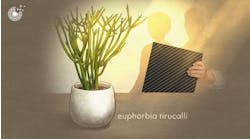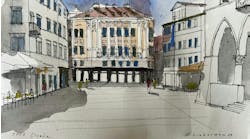Color theory affects nearly everyone, if even subconsciously. Cultures the world over have been intrigued by hues since the beginning of human history. Artifacts and records left behind have shown that our ancestors experimented with finding color. They pulverized beetles to create bright blues, harvested berries for purples or pulled reds from the clay of riverbeds.
But the science of color and color meaning changed dramatically in the 19th and 20th centuries as synthetic dyes were discovered; the textile industry rapidly expanded with new designs. But as technology has progressed, most colors are now achievable on any medium that can be printed, dyed, cast or painted.
[Color Trends for 2019 and Beyond]
Color has an important role beyond the fads you can expect to see in homes, offices, fashion and accessories. For decades, color theory has been studied as a biologic necessity passed down through evolution, explaining why we act the way we do when in the presence of a specific color.
How Our Minds and Bodies React to Certain Colors
Although the list of hues can feel limitless, human ability to see colors expands far beyond the few thousand colors we see on the market. For a majority of people, the cones — or receptors in the eye that respond to light waves and allow color to be seen — can produce up to 7 million colors in our brains.
Interestingly, of the three color-receiving cones in the human eye, about 64 percent of those respond most strongly to red, about a third react to green and only two percent respond to blue. Because of this, the ways in which we react to color are physiological, tying our body’s functions to the way we perceive the world around us. Note: The psychology of color also has ties to the cultural aspects of a society. The following are a Western interpretation.
Warm Colors: Red, Orange and Yellow
Some of the most important reminders in society are laid out in red: stop signs and lights, warning labels and the ominous big red button played out in popular culture. The reasoning comes from evolution. Red is one of the easiest colors for humans to see because it signified factors we needed to notice:
- Blood: An indication that you, an ally or an enemy was wounded
- Fire: A source of warmth, nourishment and comradery – or destruction
- Poison: As in poisonous plants and berries
Evolutionary adaptations could be why our bodies respond quickly to the color red with physical responses, such as increased heartrate and higher attention to detail. Red also is associated on a psychological level with strong emotions such as love and anger, causing similar physical responses and higher levels of energy and excitement. When using red in interiors, it’s best to use it minimally, because it can result in feelings of unease and exhaustion if the heartrate is increased for too long.
Similarly, orange and yellow can cause the heartrate to increase, leading to psychological correlations with strong feelings. However, because both colors are easily seen, orange and yellow are often used for logos of establishments such as McDonalds that are commonly seen from street-level. Orange is one of the most popular colors for professional sports teams.
It takes more light for the eye to see bright colors — particularly yellow. Overuse can cause physical visual fatigue, which is felt as abrasive rather than warm, and it is the most difficult font color to read because of eyestrain. Due to fatigue and use in fast food logos, it’s not recommended bright yellows be used in interiors as it can cause irritation and can appear cheap rather than warm as intended.
Cool Colors: Blue, Green and Purple
Cool colors are often associated with calmness, which has ties in how humans respond in nature. Particularly when it comes to blues and greens, the heartrate decreases in the presence of natural water or greenery. Today, designers call this biophilia, or the use of the natural world and its patterns, colors and aesthetic in the built environment.
As health and wellness continues to be a fixture in interiors, designers add cool hues to calming spaces such as yoga rooms, quiet individual workstations and hospital waiting rooms to induce a peaceful aesthetic.
Green — particularly those colors that correlate to outside vegetation like spring or forest greens — have calming properties and can help in the healing process. The hue has been used in healthcare applications since Kurt Goldstein observed in 1942 that patients with central nervous disorders such as Parkinson’s disease responded positively to green. Red, on the other hand, was observed by Goldstein to make patients conditions more pronounced.
Since then, color theory has been studied as a means of creating holistic healing environments. Blues and purples that contain more blue pigment than red use the fewest cones in the eye. So, widespread use of these colors in interiors won’t overstimulate and fatigue the brain and eyes like warm colors do. Therefore, cool colors are more often utilized in broad ways, such as in wallcoverings, carpets and paint colors.
One interesting aspect of blue: Beyond large-scale occurrences in nature, such as the sky and how we perceive bodies of water, blue doesn’t appear naturally as often as other colors. With the exception of a few examples like blueberries, blue is one of the hardest colors for nature to produce. Due to the lack of blue, edible items in nature, people tend to eat less when in a blue room or while using blue dishware.
Color Theory and 2019 Color Trends
With so many social and physical considerations, choosing hues for spatial design can be overwhelming. In the industry, a common solution is to look at outside influences, such as the color of the year.
According to color experts, the trending colors for 2019 will be:
- Cavern Clay, an off-orange inspired by the southwest, from Sherwin-Williams
- Metropolitan, a chameleon cool gray, from Benjamin Moore
- Living Coral, a revitalizing pink-orange, from Pantone
Interestingly, while Cavern Clay and Living Coral are both bright, bold hues, they take inspiration from nature, tying into the importance of biophilia on all aspects of design.
However, an important aspect of the colors of the year — no matter whose you go with — is that they aren’t expected to be used immediately in all aspects of interior design. Color experts for each brand typically look for patterns in society, particularly in the way fashion is headed, to determine what colors they believe will continue to trend upwards over the next two to five years. It’s a bit of a self-fulfilling prophesy as being named color of the year can lead to more people using and incorporating that color into designs, thereby guaranteeing that it continues to be used over the next several years.
Another point is to look at how the companies advertise their colors of the year to their audiences. Pantone’s color of the year is usually met with a lot of fanfare because a variety of industries — from graphic design to home good designers to fashion designers — look to and use Pantone. Many times, Pantone can be more adventurous in its color choices because they will be used for details and décor rather than for an entire space. Their advertising and media releases show the iconic Pantone swatch suspended in space on a variety of backgrounds rather than on the walls of a room.
Sherwin-Williams and Benjamin Moore create paint colors and types for a variety of interiors, so they need to be a little more conservative with their choices. Sherwin-Williams’ Director of Color Marketing, Sue Wadden, said in her podcast episode with interiors+sources that, for a while, her team considered hot pink for the annual honor. However, they were concerned about how abrasive the bright hue would be. Instead, they decided on Cavern Clay as it fit better into the biophilic trends we’re seeing in design.
When looking at Benjamin Moore’s marketing material for Metropolitan, one sees more wall photos, particularly walls near windows to show the ways in which light changes the color through use of direct lighting and shadows. The soft gray tone is suited for entire walls or rooms without being overwhelming.
Further research on the impact of color theory on psychology continues, and as science comes closer to understanding the ways in which the spaces around us affect our wellbeing, we’ll come closer to determining the best use of color in interior spaces.
Beyond Color Theory ► Daily Design News | What 'Justice' Means for Interior Design



